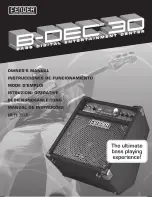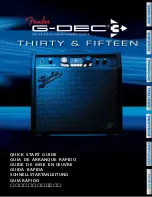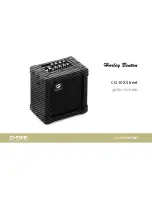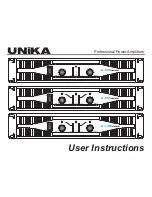
MMSR 3 Knob 2 Band
The BTB-MMSR has been designed with characteristics very similar to the original MM
Stingray 2 Band EQ, but is not a copy of the original circuit. The original used a single op-
amp chip (single amplifier stage in the form of a chip) for both bass and treble circuits,
whereas this unit utilises a moremodern dual op-amp chip (two amplifiers stages in a chip).
©
!
!
!
!
BASS & TREBLE CONTROLS
VOLUME
POWER
INSTALLATION
The design of the 2 band EQ in the early Stingray© basses is unusual in that it does not follow the types of
topologies around which the majority of equalisers are designed. It would seem that Leo Fender designed
it to create a particular sound rather than follow any conventions, such as symmetrical EQ curves.
Consequently the figures shown may appear unusual to those familiar with such specifications. In fact it's
not easy to portray what this EQ does with a few numbers, but in any case some figures, based around a
flat response input signal, are quoted as reference points.
There is more boost than cut, giving rise the characteristic 'sizzle' associated with the Stingray© style of
EQ.
The bass control has a little more boost than the original. The boost curve continues to rise towards the
lower frequencies, without flattening out at any frequency within the normal bass guitar range. Conversly
the cut characteristic is shelving, having an essentially flat response from 30 - 100Hz, when fully cut.
Sets the level from the preamp, feeding the output jack directly, like the orignal. This means that the pickup
feeds the preamp directly, allowing the best possible transfer of signal, and full interraction of the pickup
with the preamp.
This unit can be powered from 9 - 18 Volts DC.
The pots aremarked: V = Volume, B = Bass, T = Treble
The pot threads are 7.0mm size. Fit them into their holes leaving the rubber spacer rings in place if the
holes are the original larger size. Tighten them once they are in place.
Mount the preamp on the rear faces of the bass and treble pots using the foam tape on the rear of the
preamp.
Connect the pickups wires to the bass/treble circuit board, according the the BTB-MM diagram.
A battery clip is provided with the preamp allowing it to be powered directly. But most basses will have
a separate battery compartment. In which case, cut of the battery clip and join the red and black wires
from the the preamp to those in the bass. Before joining the wires, slip the heatshrink sleeves over the
joints. The sleeving can be heated with a hot soldering iron, or other localised heat source, held in
close proximity. (The heatshrink sleeves can be found threaded on the black ground wire)
Connect the black ground wire from the jack to any ground wires in the bass, such as the bridge.
NOTE:
Like the original, this circuit does not have a flat response when the controls are set midway. This
unit is not designed as a clinical tool, where what goes in, comes out at some reference setting.
!
!
TREBLE (+20dB / -16dB @ 10 kHz)
BASS (+14dB / -7dB @ 40Hz)
!
!
!
!
!
!
Содержание MMSR 3 Knob 2 Band
Страница 2: ......
Страница 3: ...East UK BTB 02 BTB MMSR 02 HOT COLD PICKUP GREEN GND ORANGE O P RED 9 18V VE...






















